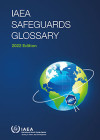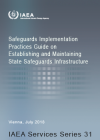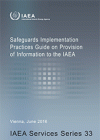Safeguards are a set of technical measures that are applied by the IAEA on nuclear facilities and material. Through these technical measures, the IAEA seeks to independently verify a State’s legal obligation that nuclear facilities are not misused and nuclear material is not diverted from peaceful uses. States accept these measures through the conclusion of safeguards agreements.
Safeguards explained
Safeguards are the means by which the IAEA verifies States’ legal commitments under their respective safeguards agreements with the IAEA. The implementation of safeguards follows an annual cycle and comprises four main processes:
- Collection and evaluation of safeguards-relevant information
The IAEA collects, processes and reviews all available safeguards-relevant information about a State to evaluate its consistency with the State’s declarations about its nuclear programme.
- Development of a safeguards approach for a State.
A safeguards approach for a State includes those safeguards measures to achieve the technical objectives for verifying the State’s declarations.
- Planning, conducting and evaluating safeguards activities
The IAEA develops a plan specifying the safeguards activities to be conducted both in the field and at the Agency’s headquarters. Once an activity has taken place, the IAEA evaluates the extent to which it has reached the technical objectives and identifies any inconsistencies that might need to be followed up.
- Drawing of Safeguards conclusions
The safeguards conclusions drawn by the IAEA are based on its independent verification and findings. They are the final product of the annual safeguards implementation cycle and provide credible assurances to the international community that States are abiding by their safeguards obligations.








